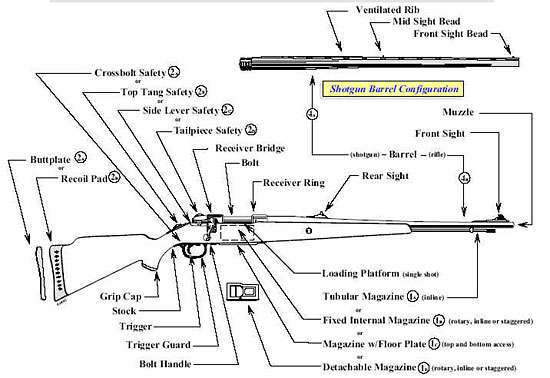The Number One Infantry Weapon in WWI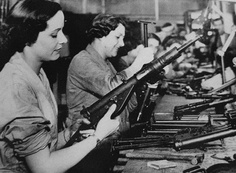
Rifles were the standard issue infantry weapon used in World War I. They did the job and were fairly cheap to produce. Unfortunately, rifles were not the best weapon to use because the were heavy, hard to shoot accurately, and required reloading often. It was obviously not very convenient to carefully aim and constantly reload your weapon whenever you were being shot at.
Rifle Stats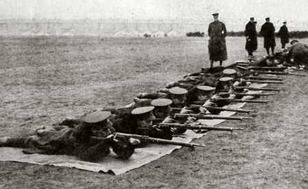
Most nations had very new army recruits. There was not enough or time or officers to help these recruits learn speed and accuracy with every shot under all circumstances. The average rate of fire for these weapons with new army recruits was about eight to twelve rounds per minute with a possible range of around 4,600 feet or 0.87 of a mile, (In Moody, it would be about the distance from C.V.S. in Moody to Jack's in Moody). Though it could shoot this far without any thing stopping the bullet it would not be an accurate shot. An accurate shot could only be made at a range of about 1900 feet or 0.36 of a mile. (In Moody, it would be about the distance from Moody Park to Freds.)
Rifle Operators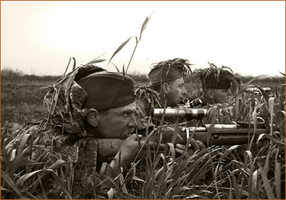
The rifle was mostly used by soldiers in the infantry on the front line in order to shoot long range and by snipers. Snipers could hide themselves and accurately shoot rifles over long ranges. Snipers were valued soldiers. They worked day and night, targeting any moving object behind enemy lines. If a sniper was taken prisoner he could expect no mercy, on either side.
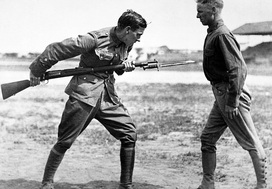
The rifle was the most used weapon because the rifle is a good offensive weapon. Rifles are long range weapons and do significant damage to moving targets. Bayonets could also be attached to rifles to make them a dual weapon. When ammunition ran out in close range combat, the bayonet could be used for self -defense and offensive battle.
Inefficiencies Lead to Improvements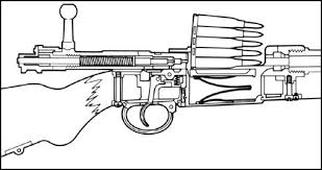
Encyclopedia - Big BerthaAlthough the name was commonly applied to a whole variety of large-calibre German artillery guns the "Big Bertha" ('Dicke Berta') actually referred to a single siege gun, at that time the world's largest and most powerful.
Sponsored Links Produced by the German firm of Krupp the Big Bertha was a 42cm howitzer, model L/14 designed in the aftermath of the Russo-Japanese War of 1904 on behalf of the German Army. It was initially used as a means of (successfully) demolishing the fortress towns of Liege and Namur in August 1914, the war's first month (and subsequently as Antwerp). It was thereafter used to similarly reduce other enemy strong-points as the need arose. The somewhat unflattering name itself arose from association with the wife of Gustav Krupp, owner of the Krupp factory. Her name was Bertha Krupp von Bohlen und Halbach. Only four Big Bertha howitzers were produced, the first two rolling off the production line a mere matter of days after the onset of hostilities, on 9 August 1914. Once constructed these huge guns, whose shells weighed 820kg each, were shipped in their constituent parts by tractor to their destination point where they were once again reassembled by a huge crew of as many as 1,000 men. With a range of 15km their 420mm shells proved devastating and all four were used during the German assault upon Verdun from February 1916. Once the Verdun offensive was called off in failure (leading to the replacement of German Chief of Staff Erich von Falkenhayn who had initiated the battle) the Big Bertha guns were decommissioned, since Allied artillery developments had resulted in guns with a longer range. Sponsored Links 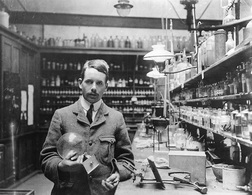
The Mark 1 howitzer was first produced just before the start of World War One in July 1914 and it was rushed into production and reached France in October 1914.
Facts: 450 of these artillery guns were built between 1914 and 1918 It weighed 15 tons It fired a 131 kg shell of high explosives It could fire this weight shell 9,198 meters It took 36 hours to dismantle and three specially built carriages to move it. Big Bertha, any of several 420-millimetre (16.5-inch) howitzers that were used by advancing Germanforces to batter the Belgian forts at Liège and Namur in August 1914, at the start of World War I. The guns were designed and built by the firm of Krupp, Germany’s largest armaments manufacturer, in the years before the war for the express purpose of overcoming modern forts built of reinforced concrete. The Big Berthas were the largest and most powerful artillery produced to that time. Each gun propelled a shell weighing 2,100 pounds (950 kg) for a distance of almost 9 miles (14 km). The shells were equipped with delayed-action fuses to explode after having penetrated a fortified target. The gun and its carriage, when fully assembled, weighed about 75 tons and was operated and serviced by a crew of about 280 men. For transport to the battlefield, the howitzer was disassembled into four sections—gun barrel, mounting, carriage, and ground platform—and loaded onto railway cars, which carried them to Belgium. After detraining, the sections were hauled by tractor-driven wagons to the firing sites and reassembled. Big Berthas and Austrian Skoda 305-millimetre howitzers were brought into action against the complex of Belgian forts around Liège on Aug. 12, 1914. They destroyed most of the forts in the next four days, thereby enabling the German army to sweep westward through southern Belgium on its way to invade northern France. Farther to the west, the forts around the city of Namur were similarly battered into surrender by Big Berthas and Skoda guns on August 21–25. According to some sources, the nickname for the guns was bestowed by the Krupps in honour of Frau Bertha von Bohlen, head of the family. In popular usage, the name Big Bertha was also applied to the extreme long-range cannons with which the Germans shelled Paris in 1918, but these guns are more properly known as Paris Guns. |
Tool BoxVocabulary to Knowammunition: the bullets or shells shot from a weapon
bayonet: a large jagged knife that attached to the end of a rifle barrel in order to turn the rifle into a thrusting weapon bolt action: when a sliding rod or bar shoves a cartridge into the firing chamber of a weapon bore: the hollow part inside a gun barrel or other tube clip: a device that is used to store multiple rounds of ammunition together as a unit to be inserted into a magazine defensive battle: a defense; when a nation or group of nations attempt to protect their territory from attack or invasion defensive weapon: a weapon - usually having a short range - made or adapted for protecting a person by causing serious injury or death to the attacker front line: the place where fighting is done face to face in a battle inefficiencies: the inability to do something in the best way possible; when something valuable (ex. time, money, lives, ammunition) is wasted in the process of doing something infantry: Infantry is the branch of an army that fights on foot — soldiers specifically trained to engage, fight, and defeat the enemy in face-to-face combat; and thus bear the brunt of warfare, and suffer the greatest number of casualties magazine: the cylinder part of a weapon that holds a clip of ammunition; used to speed up the process of loading and reloading a weapon because several rounds of ammunition can be loaded at once, rather than one round being loaded at a time manufacturing: producing a large amount of one product in a factory using machines, an assembly line, and division of labor offensive battle: an invasion; when a nation or group of nations initiate an attack with the intent of taking over territory from the nation they are attacking offensive weapon: a weapon - usually having a long range - made or adapted for attacking another person and causing serious injury or death range: the distance something has covered or reached rate of fire: the amount of bullets or ammunition a weapons can fire without having to reload rifle: a gun, esp. one fired from shoulder level, having a long spirally grooved barrel intended to make a bullet spin and thereby have greater accuracy over a long distance. sniper: a gunman who's job is to pick of targets on the opposing side in a battle because he is an expert at shooting accurately over a long range standard issue: the basic supplies given to everyone in the armed forces when they become a soldier |
